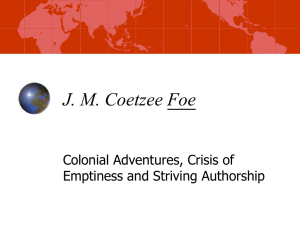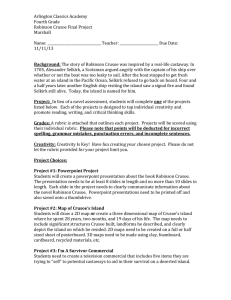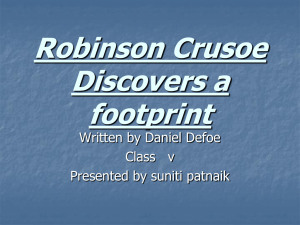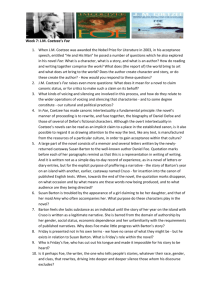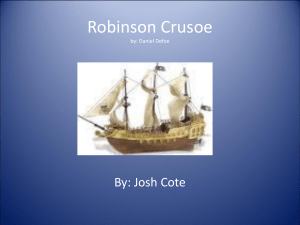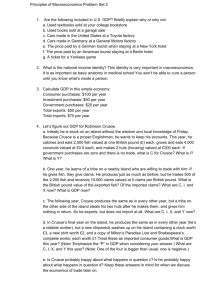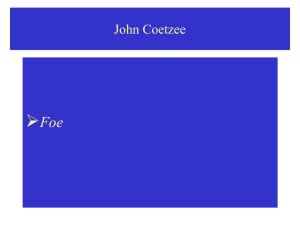PowerPoint 簡報
advertisement
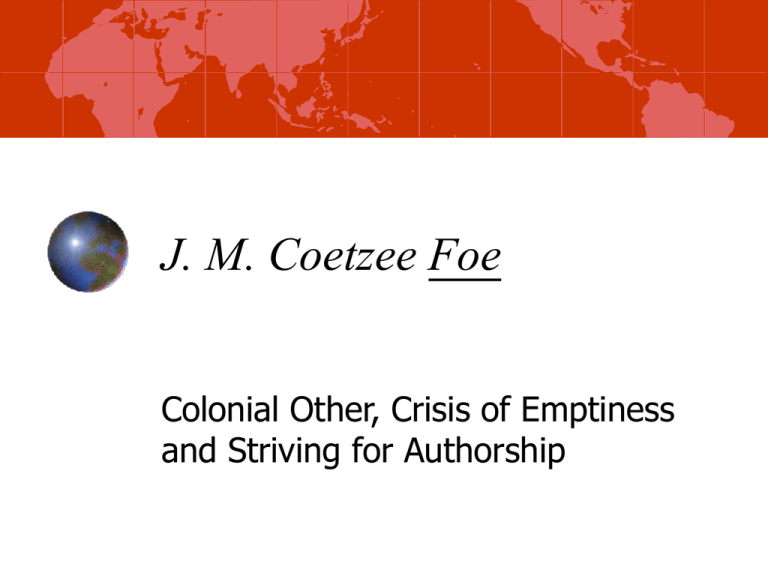
J. M. Coetzee Foe Colonial Other, Crisis of Emptiness and Striving for Authorship Outline Starting questions (1): Islands and Cannibals Examples of Colonial Texts Cannibalism Adventures on a desert island Postcolonial critique Robinson Crusoe Coetzee: Life, Style, Major Theme, and Foe Questions (2) The text: Different ways of Survival Friday Barton & Cruso “crisis of emptiness” and striving for authorship Starting Questions (1) Do you know any examples of the following stories – cannibals adventure on an “unoccupied” island; women writers in traditional society. What skin color do you think Friday has? Examples of Stories about Cannibals Discovery of the natives in the New World since Renaissance. The Tempest – Caliban Sindbad from The Thousand and One Nights: the cannibal giants of the third voyage Robinson Crusoe (1719). 吳鳳 Another Culture, Noble Savage or Barbarian (Fairy Tales, “The Modest Proposal”, Silence of the Lamb). The Westerners’ Views of Cannibalism 16th -century travelers and writers – viewed "man-eating savage of the Americas“ positively as as a hero who devoured his defeated enemy in accordance with custom; (e.g. Montaigne “Of Cannibals and Man.”) 18th c: Enlightenment philosophers -- used the figure of the cannibal in their fight against colonialists and Catholics. Since the end of the 18th century -- a hateful figure Cannibalism & Africa After the British abolished slavery in England, they and other Europeans took up the task of abolishing all of what they considered savage customs on the African continent. By the time of the Berlin Conference, the Europeans regarded all of Africa as a center of evil, as a part of the world possessed by a demonic darkness, or cannibalism, which demonism was their Christian duty to eradicate. Writers during the Victorian era such as missionaries and explorers were responsible for promoting this dastardly image of Africa.(source) Adventures on a desert island No Man’s Land Savage, filled with latent dangers, and in need of civilization Deserted and an earthly paradise e.g. 1; The Tempest "This Island where Man doth not Inhabit." Prospero, Ariel, Miranda and Caliban CALIBAN -- You taught me language; and my profit on't Is, I know how to curse. Adventures on a desert island e.g 2: The Blue Lagoon (1980) E.g. 3 Enfant d’eau e.g. 4: THE ADVENTURES OF ROBINSON CRUSOE Origin: Alexander Selkirk alone on the island.. "four years and four months." Location: The Juan Fernandez group of islands -- 360 miles from Valparaiso, Chile. There is now a thriving community on the islands and the worldwide popularity of Defoe's book is reflected in the current names of the islands - Isla Alejandro Selkirk, and Isla Robinson Crusoe. (source: http://www.dwest.pwp.blueyonder.co.uk/crusoe2.html ) The Juan Fernandez islands THE ADVENTURES OF ROBINSON CRUSOE Defoe’s embellishments: shipwrecks, mutineers, and cannibals. the book’s influences: its support of Enlightenment rationalism and colonial discourse of ‘civilization vs. savagery’ more THE ADVENTURES OF ROBINSON CRUSOE: style & influences Puritan spiritual autobiography; A celebration of hard work and faith (G 169). E.g. his calculation: "twenty-eight years, two months, and nineteen days.“ By 1895 – 115 revisions, 277 imitations, 110 translations, 196 English editions. (Atwell 133) Crusoe "I stood like one Thunder-struck, or as if I had seen an Apparition...“ (Chapter XVII) a self-centered, selfabsorbed individual after two decades alone Crusoe discovers and rescues Man Friday. Friday’s appearance (chap XXII) He was a comely handsome Fellow, perfectly well made; with straight strong Limbs, not too large; tall and well shap'd, [. . . ]. He had a very good Countenance, not a fierce and surly Aspect; but seem'd to have something very manly in his Face, and yet he had all the Sweetness and Softness of an European in his Countenance too, especially when he smil'd. His Hair was long and black, not curl'd like Wool; [. . .]. The Colour of his Skin was not quite black, but very tawny; and yet not of an ugly yellow nauseous tawny, as the Brasilians, and Virginians,and other Natives of America are; but of a bright kind of a dun olive Colour, that had in it something very agreeable. . . Images of Friday In the novel, Friday’s racial/cultural identity is unclear. Later in illustrations, he is identified as either African or Indian, either a noble savage or Europeanized native (like Crusoe). However, there is a growing emphasis on his African identity. (Ref. Quilley 41-43) Coetzee also sees Friday as an African. Images of Friday “Map of Robinson Crusoe’s Island” 1720– Europeanized black, dressed like Crusoe (source Quilley 41) Images of Friday as Noble Savage 1790 --white 1790 black Friday Master & Slave "...and then he kneel'd down again, kiss'd the Ground, and laid his Head upon the Ground, and taking me by the Foot, set my Foot upon his Head...“ (source) Chapter XXII --subservience . . .At last he lays his Head flat upon the Ground, close to my Foot, and sets my other Foot upon his Head, as he had done before; and after this, made all the Signs to me of Subjection, Servitude, and Submission imaginable, to let me know, how he would serve me as long as he liv'd; … Chapter XXII –naming and teaching of language I understood him in many Things, and let him know, I was very well pleas'd with him; in a little Time I began to speak to him, and teach him to speak to me; and first, I made him know his Name should be Friday, which was the Day I sav'd his Life; I call'd him so for the Memory of the Time; I likewise taught him to say Master, and then let him know, that was to be my Name; I likewise taught him to say, YES, and No, and to know the Meaning of them; THE ADVENTURES OF ROBINSON CRUSOE: criticisms James Joyce: prototype of colonist -- “cast away on a desert island, in his pocket a knife and a pipe, [he] becomes an architect, a carpenter, a knife grinder, an astronomer, a baker, a shipwright, a potter, a saddler . . . “ Lewis Nkosi: “[the myth of] building a civilization from nothing is inseparable from the story of colonization, of subjugation, exploitation, and finally christianization” (G 170). J. M. Coetzee: Life & Style an Afrikaner who speaks Afrikaans, has forbears involved in instituting apartheid, is now critical of his own tradition and heritage. sees the South African situation as a manifestation of "colonialism, late colonialism, neo-colonialism." (GALLAGHER 15) Non-Realistic; Self-Reflexive (about writing itself) (different from Gordimer) Theme: colonialism & decolonization Dusklands -- aggressive imperialist violence –in Vietnam and 18th century South Africa; In the Heart of the Country -- setttlement of uncertain standing and duration in a remote farm in South Africa. Waiting for the Barbarians -- anticipated revolution –”a frontier town” Life and Times of Michael K -- open civil warfare. - in an unspecified future -- stories set in a broader and broader colonial context. Most recent work: The Master of Petersburg杜斯妥也 夫斯基為躲債而自我流放德國, news about his son’s death. Theme:colonialism & decolonization 2 Foe -- set in an island in South America -- power and authority under colonialism, specifically, the power and authority of a mode of authorship straddling the metropolis (London) and the colony (island). Sailors, Slave traders Police, debtors Cruso Susan Barton Foe Friday "Daughter" Coetzee’s revision of Robinson Crusoe adding Susan Barton – as a marginalized figure; turning Friday into a Negro, with his tongue cut off; turning Cruso into one focusing on his own mastery and futile task but with growing cynicism and indifference to the surroundings. a story about Susan Barton’s striving for authorship. Coetzee’s revision of Robinson Crusoe: Purposes direct critique of colonialism; concerned specifically with the white writers’ ambiguous positions in South African literature: e.g. “A Cruso on his island is a better thing than the true Cruso tight-lipped and sullen in an alien England” (35) Afrikaners began to turn their backs on Europe at approximately the time Defoe was writing. Coetzee’s revision of Robinson Crusoe: Purposes (2) Cruso’s love of emptiness in the seascape Coetzee’s criticism of the “settler’s love of the land and landscape at the expense of the polity” (“Apartheid” 124; Atwell 107-108) on Friday: “Friday [in Robinson Crusoe] is a handsome Carib youth with nearEuropean features. In Foe he is an African” (qtd in Atwell 108) Foe: Structure Chap 1: her experience on the island; (Barton’s “speech” to Foe) Chap 2: Barton and Friday in London, first in Clock Lane, and then moving to Foe’s attic; writing letters to Foe (epistolary form) Chap 3: Barton going to join Foe in his hiding place, discusses writing more; (B’s narration) Chap 4: from Foe’s attic to “dive into the sea wrecks”; a first-person narration Chap 1: Plot Summary (1) “At last I could row no further.” Barton going to the island; Meeting Friday first and then Cruso; Telling C. her story, but getting different versions of his. Cruso’s hut and personalities described. Friday’s tongue B & C: B rebellious first, compromising, taking care of him, allowing him to have sex; B -- Lethargy regaining interest and energy Chap 1: Plot Summary Cruso sick again The arrival of another boat, which takes the three of them aboard. Susan’s trying to comfort Cruso His death Starting Questions 2 What would you do if you were on an island like this? With a man? Please contrast Susan Barton and Cruso ways of survival on the island Ways of treating Friday Ways of treating each other Why does Cruso die on the ship? Friday –why is his lost tongue so important for Susan? Is there anything special in Susan’s narration? Is she a good story-teller? Susan Barton vs. Cruso-Survival: Her view of the island 7, 14, 15, excursion and apes 20-21, feel it rock 26, Her story to Cruso 10 Wants to keep record 1617 (more later) ; remembers the shipmaster 21 Desires to be saved (36); find ways to go home (32) Survive her dark days 35 Cruso’s place: 9; His stories: 11-12; No escape 13-14; Wanting to control everything 20; 25 No journals 16, no need to remember (17); no stories 34; Futile work 34 (‘not a castaway at heart’); law (work for the bread) 36 Looks at the empty sea scape 38 Susan Barton vs. Cruso-- Friday Barton –Friday Wants to teach him language, p. 24, sympathy for his experience fear of and Sympathy for his loss 24 42 His offering of white petals 31-32 Disagrees with Cruso’s not teaching him language 56 Cruso Teach him only the words he needs 21 Friday’s tongue 23 Susan Barton vs. Cruso-- mutual relations Cruso Barton Sympathy for Cruso (about his bitterness 25; miserty 37) Soothing him in his illness;p. 29, Agree to having sex with him 29-30; Grateful 35; Speaking to him and comforting him on the ship 43-44 Indifferent to Bartonp. 9 After sex, he is still irresponsive; Weeps p. 44 Cruso "crisis of emptiness" Happens when the agents of colonialism find themselves without strong ethical and ideological support of colonialism. a significant determinant of white South African writing, Some writers like Coetzee: choose to “[erode] one's own biases“ in writing. (Tiffin qtd in Atwell 23). Coetzee’s way: challenges his (his race) authority as a writer and producer of literary canon. Barton’s wanting to tell stories Chap 1: “Let me tell you my story.”(10) --to Cruso, also tell her stories to the Captain and to Foe; chap 2: insists on writing to Foe, to have her story told and sold. chap 3: to his hiding place: “The history of ourselves and the island—how does it progress? Is it written?” Why? Is she logo-centric in insisting on writing her stories and teaching Friday to speak? Barton’s wanting to tell stories p. 17-18 – helps one remember “the particulars”; remember nice people 19; p. 45 – “it is I who have disposal of all that Cruso leaves behind, which is the story of his island.” an inheritance, something to make permanent; next chapter: way to achieve fame, fortune, to acquire “substance” of her identity (51) not being able to solve all the mysteries of her story. Barton’s story-telling sense of immediacy: address to “you.” expecting audience response (7) Re-telling the stories to remember them (repetition p. 5; 11) “imagine” things into existence: Foe’s place (p. 49); imagining the island and presenting it to Foe 53, for Friday to cross to the time before Cruso 60, etc. Wants her story to be “truthful” 40. Barton and Friday Cannot she be exempt from being a colonizer? She needs to communicate and establish relations the gap between B and Friday p. 45 The issue of Language – 1. 2. 3. loss of mother tongue, adoption of colonizers’ language (e.g. African Americans); englishes: mixture of mother tongue into English; In settlers’ colonies: having to use the master’s language. References ATWELL, David. J.M. Coetzee: South Africa and the Politics of Writing. Berkeley: U of California P, 1993. GALLAGHER, SUSAN. A Story of South Africa J. M. Coetzee's Fiction in Context. Harvard University Press, 1991. The Life and Adventures of Robinson Crusoe E-Text http://www.deadmentellnotales.com/onlinetexts/robin son/crusoe.shtml Geoff Quilley and Kay Dian Kriz, ed. An Economy of Colour: Visual Culture and the Atlantic World, 16601830. Manchester University Press (2003)
